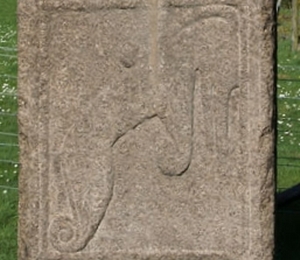Pictish Beast
Artistic representation of an unknown, possibly mythical creature in Pictish stone monuments From Wikipedia, the free encyclopedia
Artistic representation of an unknown, possibly mythical creature in Pictish stone monuments From Wikipedia, the free encyclopedia
The Pictish Beast (sometimes Pictish Dragon or Pictish Elephant) is an artistic representation of an animal, distinct to the early medieval culture of the Picts of Scotland. The great majority of surviving examples are on Pictish stones.
This article needs additional citations for verification. (April 2015) |


The Pictish Beast accounts for about 40% of all Pictish animal depictions, and so was likely of great importance.[citation needed] The Pictish Beast is thought[by whom?] to have been an important figure in Pictish mythology, and possibly even a clan or political symbol.[citation needed]
A comprehensive collection of depictions of the Pictish Beast was given by Stuart as Plate 22 in Sculptured Stones of Scotland Volume 2, 1867.[1] Depictions are shown at a consistent scale and oriented as they were on the stones. The sequence in which they appear is described[1] as
indicating their development from the outline form in which they first appear on the rude pillars, to that in which the outline is filled up with the ornamental devices of the cross-slabs

The Pictish Beast is not easily identifiable with any real animal, but resembles a seahorse, especially when depicted upright. Suggestions have included a dolphin, an anteater, an elephant, a kelpie (or each uisge), and even the Loch Ness Monster.[citation needed] Chanonry Point and the Sutors of Cromarty lie close to the Pictish monasteries at Portmahomack and Rosemarkie and are recognised as some of the best sites in Britain for viewing bottlenose dolphins from the land.
Recent[when?] thinking[by whom?] is that the Pictish Beast might be related to the design of dragonesque brooches, which are S-shaped pieces of jewellery, made from the mid-1st to the 2nd century CE, that depict double-headed animals with swirled snouts and distinctive ears. A few[quantify] of these have been found[where?] in Scotland, though the great[quantify] majority have been found in northern England. The strongest evidence[according to whom?] for this is the presence on the Mortlach 2 stone of a symbol very similar to such a brooch, next to and in the same alignment as a Pictish Beast.[citation needed]
Seamless Wikipedia browsing. On steroids.
Every time you click a link to Wikipedia, Wiktionary or Wikiquote in your browser's search results, it will show the modern Wikiwand interface.
Wikiwand extension is a five stars, simple, with minimum permission required to keep your browsing private, safe and transparent.